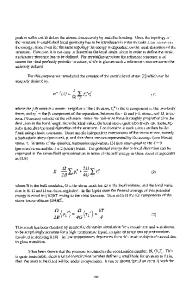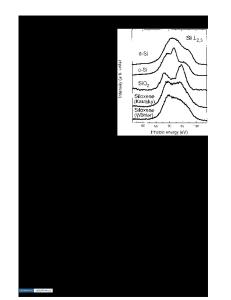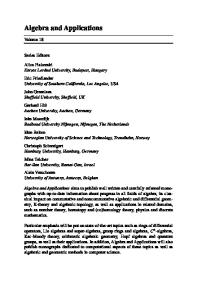Local Structure of MD Simulated Soda-Lime-Silicate Glass
- PDF / 392,753 Bytes
- 6 Pages / 414.72 x 648 pts Page_size
- 3 Downloads / 303 Views
ABSTRACT Simulation of soda-lime-silicate (sis) glass has been performed using molecular dynamics (MD). The local structure of each component is analyzed extensively in terms of total radial distribution function and coordination number and found to be insensitive to the composition 4 2 change. Because of its big size, Na+/Ca ÷ shows a behavior rather like O2- instead of Si +. It is evident that the CN and local structure of Na+ with 02- are similar to those in crystalline a2 Naz5i2 Os. Finally, the Na+/Ca ÷ cluster phenomenon is discussed. INTRODUCTION The complexity of silicate glasses is well known and it has taken a great deal of time and ingenuity, coupled with advanced experimental techniques, to provide the detailed understanding that exists today. Techniques such as x-ray absorption fine structure (XAFS), neutron diffraction, MAS-NMR and x-ray photoemission spectroscopy (XPS) have been very important in elucidating the detailed structure. l-4 Based on such techniques, a modified random network (MRN)' has emerged which is characterized by the microsegregation of glass modifiers and glass formers, the boundaries being defined by non-bridging oxygen ions (NBOs). According to this model, glass modifiers will form clusters between the bridged [SiO 4] units, to which they are linked predominantly via NBOs. As the modifier is generally the minority component, it will form channels separated by network regions. The extent of the modified regions is clearly 5 6 governed by the glass composition. Previous MD simulations , have provided support for this model. The coordination number (CN) of glass modifiers in glasses is not easy to determine considering its ill-defined shell. In practice, the CN is defined as the average number of nearest neighbors surrounding the central atom. The nearest neighbors are usually those lying within a given radius. However, this radius for modifiers is not easy to define and reporting CN without referring to radial distance is often inappropriate. 2 In this study, the local structure and CN of each species and the Na+/Ca + cluster are fully discussed in terms of total radial distribution function, T(r), bond angle distribution (BAD) and CN(r). The Q., species and ring size distribution (RSD) containing unique ring up to 14 numbers have also been calculated and a detailed analysis will be reported subsequently. SIMULATION METHODS Although silicate glass is mainly thought to be a covalent bonded framework structure, full ionic charges on both silicon and oxygen species are employed for long-range Coulomb potential calculation using Ewald's method. The charges on the ions here should be regarded simply as parameters in the potential model. The covalent character of the Si-O bonds is modelled by using 241 Mat. Res. Soc. Symp. Proc. Vol. 455 © 1997 Materials Research Society
the Truncated Vessal three-body potential 7 modified by Smith and Greaves. 8 A four-range Buckingham potential based on that of Vessal et al.9 is used to model the short-range interactions. The Na'-O2 - interaction was
Data Loading...










